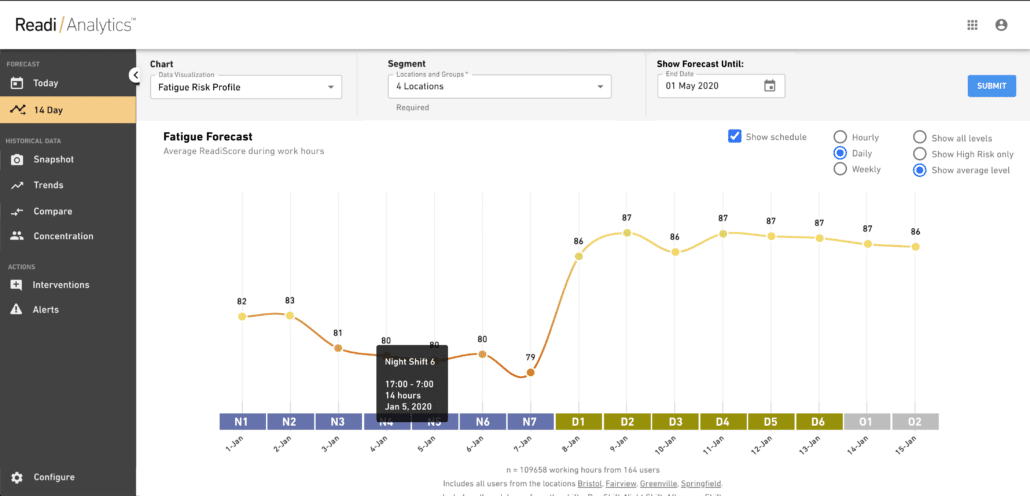
Breakthrough fatigue management technology reducing uncertainty and enabling workforce planning 14 days in advance
Fatigue Science, the global leader in providing human fatigue and performance predictive analytics and fatigue management information systems to heavy industry, military, and elite sports teams, is pleased to announce the launch of 14-Day Fatigue Forecasting, a breakthrough advancement in fatigue management technology and powerful new addition to its Readi™ Enterprise Suite software platform.
Readi Enterprise Suite, the Fatigue Management Information System from Fatigue Science, is widely relied upon for its ability to provide objective historical and real-time visibility into workforce fatigue. Now, the release of 14-Day Fatigue Forecasting expands this visibility into the future, providing the world’s first “360º view of fatigue – past, present, and future.” With this advancement, proactive planning measures and proactive safety-critical actions that were previously impossible are now visible and achievable.

“Our customers across heavy industry, military, and elite sports have long understood that the further in advance they identify fatigue challenges, the more effectively they can prepare for and manage it,” says Andrew Morden, President and CEO of Fatigue Science. “While real-time and historical insights certainly play an important role in fatigue management, our customers have long envisioned identifying and managing both routine and mission-critical fatigue hotspots weeks in advance of the problem. This window of time makes proactive measures, both practical and executable.”
With 14-Day Fatigue Forecasting, supervisors and management can now view fatigue projections showing the “who, when, and where” of workforce fatigue over the next two weeks. An authorized supervisor can view a heatmap of their crew members, spotting at-a-glance any workers who are likely to become fatigued in the next two weeks, and on which specific days. Supervisors can then reach out to individuals, sharing data-backed guidance to focus on sleep on certain days and to be particularly cautious at work when those days arrive. Moreover, supervisors can plan critical tasks for the times of least fatigue, choosing the right worker for the right task, at the right time.
At the group level, superintendents can assess the fatigue forecast of all the crews they manage, and ensure that crew supervisors are aware of which days their crew is likely to face the highest fatigue – as well as any “hotspot hours” on those days. A crew may discover, for instance, that the period from 3:00 am to 5:00 am on the 4th night shift next week poses an outsized fatigue risk for complex tasks. Conversely, teams can also identify their lowest risk, highest productivity hours, and plan the most complex or challenging tasks for those times.
“From a supervisor’s perspective, it’s more than just an eye-opener – Fatigue Forecasts provide specifically actionable data that enables you to match workers to the appropriate task at the optimal time,” says Robert Higdon, VP of Product & Corporate Development.
“And from a worker’s perspective, it’s valuable to know when fatigue is likely to hit you the hardest – far enough in advance that you still have a chance to avert it. Practically speaking, this is a ‘heads up’ that you can actually act on, focusing on your sleep and potentially staving off some of the worst fatigue to come,” adds Higdon.
“Putting forecasts in the hands of our key customers, we see supervisors asking questions that were previously impractical. ‘We’ve got a high fatigue day coming up next Tuesday. What are we doing to prepare for it?, ” says David Trotter, Senior VP of Sales & Marketing. “Instead of just suspecting that fatigue is coming, teams are now planning their most challenging tasks for the lowest risk times, and alerting workers who are likely to be most impacted.”
A Significant Advancement on FAST® Technology, the Trusted Tool for Fatigue Modeling
14-Day Fatigue Forecasting is built on top of FAST®, Fatigue Science’s Fatigue Avoidance Scheduling Tool, which has been widely used for decades by flight schedulers, mission planners, and elite sports teams to model fatigue in schedule simulations.
FAST is renowned for its use in the US Air Force, the Federal Aviation Administration, and a large percentage of global airlines for schedule optimization. Fatigue Science has now built FAST® technology directly into 14-Day Fatigue Forecasting, leveraging each crew’s schedule as a starting point for their forecast.
On top of this foundation, 14-Day Fatigue Forecasting offers a significant advancement over FAST. Whereas FAST’s simulations are based on generic sleep assumptions, in 14-Day Fatigue Forecasting, each forecast is personalized using the unique and specific sleep profiles of each participant – data which are collected from validated wearables in Readi Enterprise Suite.

This personalization represents a fundamental step-change for schedule modeling at large – with the takeaway that simulations are now grounded in real-world conditions that pertain directly to the individuals working those schedules. In practical terms, this means schedule simulations are no longer just conceptual exercises to perform once a year when considering schedule changes. Instead, they are meaningful forecasts that supervisors can act on in day-to-day operations.
Of course, schedulers themselves, the traditional users of FAST, also stand to benefit from forecast personalization. Choosing the right schedule for the right crew may depend on personal sleep factors, and schedulers can now take this into account using Fatigue Forecasting, offering them the chance to present significantly more personalized and relevant schedule recommendations.
Machine Learning on Top of the Foundation of SAFTE™
Fatigue Forecasting will continue to grow even more personalized over time, as Fatigue Science applies Machine Learning to its forecasts, continuously improving projections by leveraging contextual data unique to each situation, and comparing forecasts to actual data once it’s recorded by wearables. Customers who adopt Fatigue Forecasting early will have the most to gain, as they’ll have accrued the largest data sets informing their forecasts going forward.
Finally, underneath it all remains the established SAFTE Biomathematical Fatigue Model, the proprietary algorithm developed by the Walter Reid Army Institute of Research at the U.S. Army and validated extensively by leading institutions such as the U.S. Department of Transportation and Federal Aviation Administration. SAFTE is the engine that converts sleep and circadian factors into an objective fatigue prediction, quantifying its effects on cognitive effectiveness, reaction time, and lapse likelihood.
Productivity, Safety, and ROI: Reducing Uncertainty with a 360º View of Fatigue
In recent months, new telematics studies released by Fatigue Science have provided further evidence of the significant relationship between workers’ fatigue levels and the productivity and safety outcomes of industrial operations. “When we showed mining customers their own data revealing the productivity gains possible when fatigue is managed for haul truck or mining shovel operators, they immediately made process changes to ensure more workers are performing key tasks when they were ‘in the green [low fatigue zone]’,” adds Morden. 14-Day Fatigue Forecasting now enables organizations to take full advantage of that correlation.
“Now, customers can actually plan out weekly tasks for those highest productivity and safest times of day – and avoid planning specific complex tasks for the riskiest times. The potential impact on productivity and worker safety here is massive,” says Morden.

As workforces continue to face strain from COVID-19, the need to reduce uncertainty is a more prominent C-Suite concern, and planning tasks with greater confidence is a core part of today’s reality. “When we released fatigue analytics this past May, customers saw this as eliminating a historical blind-spot, just as telematics and IoT data did for equipment,” says Morden.
“Now, Fatigue Forecasting is akin to predictive maintenance, which enables operations teams to plan the future with greater certainty, before critical needs arise,” says Morden. “Where our solutions have already helped customers achieve a payback within weeks to months, we now see an acceleration of that return on investment with Fatigue Forecasting, all the while improving the health and safety of employees at a time of global need.”
Fatigue Forecasting is launching today with deployments at several major global mining firms, with many more slated to deploy in the coming weeks. All existing customers with access to ReadiAnalytics have immediate access to Fatigue Forecasting as part of their subscription.
Interested in learning more about data-driven fatigue management?
or download our free eBook on the Science of Sleep for industrial workforces
About Fatigue Science
Fatigue Science is the leading provider of predictive human performance data in heavy industry, elite sports, and military. Headquartered in Vancouver, Canada, we build software that leverages scientifically-validated biomathematical models in order to quantify and predict the cumulative effects of sleep disruption on human reaction time and cognitive effectiveness. Our solutions enable organizations to optimize operations, reduce risk, and drive performance and productivity improvements — both at an individual- and enterprise-level. With proven impact, return on investment, and significant and growing traction in heavy industry, military, and elite sports, Fatigue Science serves cutting-edge organizations who understand the importance of sleep as well as the value of data-driven decision-making.